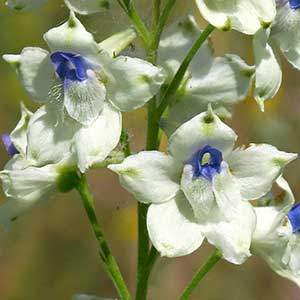Delphinium nuttallii subsp. ochroleucum
(synonym of Delphinium leucophaeum)
Delphinium hutchinsoniae
pale larkspur, white rock larkspur
Hutchinson's delphinium, Hutchinson's larkspur, Monterey larkspur
30-60 cm.
(25-)50-80(-100) cm;
base reddish, not longitudinally ridged, variably puberulent.
blade round to pentagonal, 1-6 × 1.5-10 cm, puberulent; ultimate lobes 3-17, width 4-16(-25) mm (basal), 1-8(-19) mm (cauline).
(2-)7-20(-31)-flowered, open;
pedicel 1-4(-6) cm, puberulent;
bracteoles (2-)8-12 mm from flowers, green, linear, 3-6(-9) mm, puberulent.
sepals white or light yellow, spurs 9-11 mm;
lower petal blades 4-6 mm.
sepals dark bluish purple, puberulent, lateral sepals spreading, (12-)14-19(-24) × 7-12(-15) mm, spurs ascending, decurved apically, 11-19 mm;
lower petal blades slightly elevated, mostly covering stamens, 5-10 mm, cleft 2-3 mm;
hairs sparse, mostly on inner lobes, absent on margins, white.
9-21 mm, 2.5-4.2 times longer than wide, sparsely puberulent.
not echinate, ± smooth to naked eye;
seed coat cells with margins ± undulate, surfaces smooth.
= 16.
Delphinium nuttallii subsp. ochroleucum
Delphinium hutchinsoniae
Of conservation concern.
The range of morphologic features of Delphinium nuttallii subsp. ochroleucum (D. leucophaeum) is almost completely encompassed within that of D. nuttallii subsp. nuttallii. Sepal color is the only feature consistently separating the two subspecies. Were it not for the fact that any given population typically has plants of only one flower color, a rank of forma would be more appropriate.
(Discussion copyrighted by Flora of North America; reprinted with permission.)
Of conservation concern.
Delphinium hutchinsoniae is known from only a few populations near Monterey and south to the Big Sur region. Hybrids have been produced between D. hutchinsoniae and D. cardinale grown in a common garden. Hybrids also occur with D. parryi subsp. maritimum.
Delphinium hutchinsoniae is similar, and probably closely related, to D. variegatum. The two may be distinguished by the decurved spur of D. hutchinsoniae; the spur of D. variegatum is normally straight (or decurved nearer apex). Delphinium hutchinsoniae lacks marginal hairs on lower petals; such hairs are present in D. variegatum. The two species are also geographically separated.
(Discussion copyrighted by Flora of North America; reprinted with permission.)


